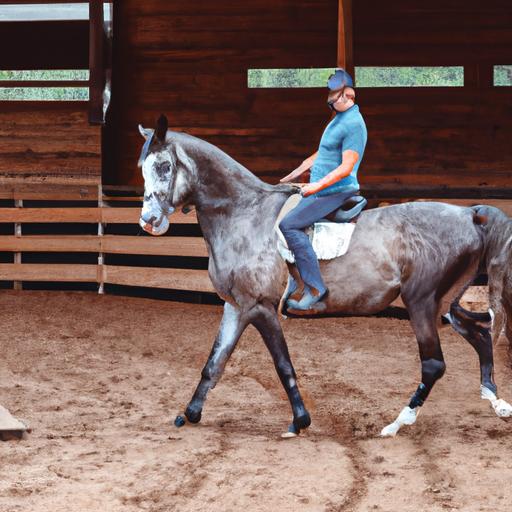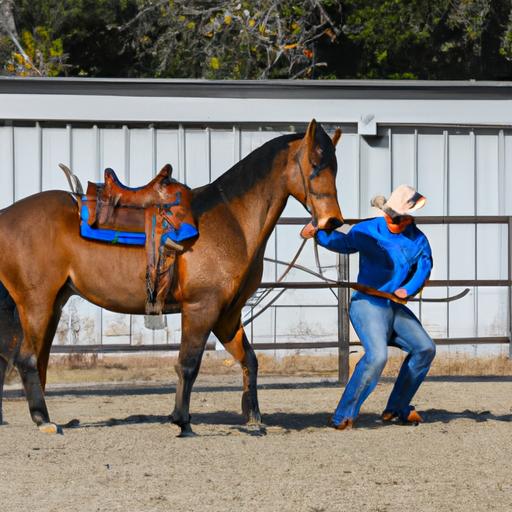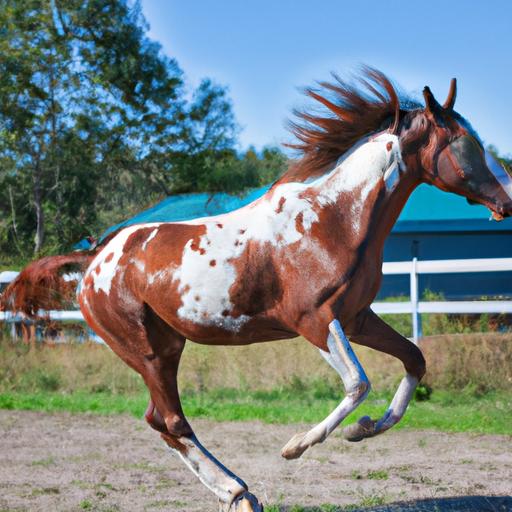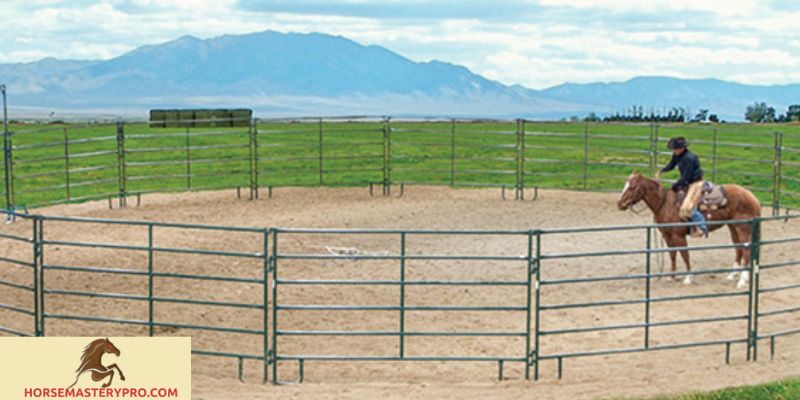Discover the key elements of setting up a round pen for horse training. Learn about location, footing, fencing, and equipment for optimal results.
Have you ever wondered what sets apart exceptional horse trainers from the rest? It’s their ability to harness the full potential of round pens for horse training. These remarkable enclosures serve as a gateway to unlocking the true essence of equine excellence. In this article, we will explore the importance of round pens in horse training and the myriad of benefits they offer to both trainers and horses alike.
Importance of Round Pens in Horse Training
Round pens, specifically designed for equine training, provide a controlled environment where horses can learn, develop, and thrive. They offer an enclosed space that allows trainers to establish clear boundaries, fostering a sense of security and trust between human and horse. By utilizing round pens, trainers can effectively communicate with their equine partners, leading to enhanced understanding and cooperation.
Benefits of Using Round Pens for Horse Training
Round pens serve as an invaluable tool in the horse training arsenal, offering a multitude of benefits that contribute to the overall success of training sessions. Firstly, the circular shape of these pens encourages horses to move in a natural, unrestricted manner, mimicking their instinctual behavior in the wild. This freedom of movement allows horses to release excess energy, resulting in a calmer and more focused equine partner.
Furthermore, round pens provide trainers with a controlled space to work on horsemanship skills, such as building trust, establishing leadership, and refining communication. In this controlled setting, trainers can observe and correct their own body language, ensuring that their cues are clear and consistent. The intimacy of the round pen also allows for heightened focus, minimizing distractions and maximizing the horse’s ability to learn.
In conclusion, round pens are an essential component of successful horse training. They offer a safe and controlled environment where trainers can establish trust, refine communication, and unlock the full potential of their equine partners. Join us in the next section as we delve deeper into the world of round pens and explore how to set up a perfect training arena for your horse. So, let’s continue our journey towards horsemastery with Horsemasterypro.com.
Understanding Round Pens for Horse Training

Definition and Purpose of Round Pens
Before we dive into the intricacies of round pens for horse training, let’s establish a clear understanding of what they are and why they are essential. Round pens are enclosed training arenas typically constructed in a circular shape, allowing for uninterrupted movement of the horse. They provide a controlled space where trainers can establish boundaries, work on communication, and build trust with their equine partners.
The purpose of round pens goes beyond confinement; they are designed to create an environment that closely mimics the horse’s natural instincts. By allowing free movement in a circular path, trainers can tap into the horse’s innate desire to move and respond to non-verbal cues. This natural approach to training promotes a deeper connection between horse and trainer, leading to more effective training outcomes.
Ideal Size and Materials for Round Pens
When it comes to round pens, size does matter. The ideal diameter for a round pen typically ranges between 50 to 60 feet. This size offers enough space for the horse to move comfortably while still maintaining a level of control for the trainer. However, it’s important to consider the specific needs of your horse and the intended training activities when determining the appropriate size for your round pen.
In terms of materials, durability and safety are of utmost importance. Round pens can be constructed using a variety of materials, including wood, metal, or PVC. Each material has its own advantages and considerations, such as maintenance, cost, and safety. It’s crucial to choose materials that are sturdy, secure, and able to withstand the rigors of horse training.
Safety Considerations for Round Pens
Safety should always be a top priority when working with horses in round pens. Proper fencing and gate systems are essential to prevent accidents and ensure the horse’s well-being. The fencing should be strong, tall enough to discourage jumping, and designed to minimize the risk of entanglement or injury.
Additionally, the footing within the round pen plays a crucial role in maintaining a safe training environment. It should provide adequate traction to prevent slips and falls, while also offering enough cushioning to minimize the impact on the horse’s joints. Regular maintenance and monitoring of the footing are necessary to ensure its integrity and safety.
By understanding the definition, purpose, ideal size, and materials, as well as prioritizing safety considerations, you can create a round pen that optimizes your horse’s training experience. In the next section, we will explore the crucial steps involved in setting up a round pen for horse training. So, let’s continue our journey towards horsemastery with Horsemasterypro.com.
Effective Horse Training Techniques in Round Pens

Round Pen Basics: Establishing Boundaries for Success
When it comes to training horses in round pens, establishing clear boundaries is paramount. Begin by setting a perimeter for the horse to navigate within, ensuring it is spacious enough for the horse to move comfortably. This boundary serves as a foundation for effective communication and helps the horse understand the desired area for training.
Building Trust and Developing a Relationship with the Horse
Round pens provide the perfect setting for trainers to build trust and foster a strong bond with their horses. Take the time to connect with your equine partner by using gentle and consistent body language. Focus on building a relationship based on mutual respect and understanding, establishing yourself as a trusted leader. By creating a safe and positive environment within the round pen, you can nurture a partnership built on trust and cooperation.
Applying Natural Horsemanship Techniques in Round Pen Training
Natural horsemanship techniques are highly effective when utilized in round pen training. These methods emphasize communication and understanding the horse’s natural instincts. By observing and responding to the horse’s body language, trainers can effectively communicate their intentions and establish a language of trust. Incorporate techniques such as join-up, where the horse voluntarily connects with the trainer, as well as desensitization exercises to build confidence and responsiveness.
Utilizing Lunging Exercises and Free Lunging
Lunging exercises are a valuable tool in round pen training, allowing trainers to engage the horse both physically and mentally. Through lunging, horses can develop balance, coordination, and responsiveness to commands. Gradually introduce lunging exercises, starting with basic commands and gradually progressing to more advanced maneuvers. Additionally, free lunging allows the horse to move in a relaxed and natural manner, encouraging self-expression and physical conditioning.
In summary, effective horse training techniques within round pens involve setting clear boundaries, building trust, applying natural horsemanship methods, and incorporating lunging exercises. These techniques promote communication, mutual understanding, and physical development. Join us in the next section as we explore common mistakes to avoid in round pen training, ensuring a successful and harmonious training experience. So, let’s continue our journey towards horsemastery with Horsemasterypro.com.
Common Mistakes to Avoid in Round Pen Horse Training

When it comes to round pen horse training, avoiding common mistakes is crucial to ensure the success and well-being of both you and your equine partner. Let’s explore some of the most prevalent pitfalls and how to steer clear of them.
Overworking or Pushing the Horse Too Hard
One of the biggest mistakes trainers make is pushing their horses beyond their physical and mental limits. Remember, training should be a collaborative journey, not a forced march. Overworking can lead to physical strain, mental burnout, and even resistance or behavioral issues in the horse. Always prioritize the horse’s well-being and listen to their signals. Know when to take breaks, vary the exercises, and create a balanced training routine that promotes both progress and rest.
Inconsistent or Improper Use of Body Language
Communication is the foundation of successful round pen horse training, and your body language plays a significant role in this exchange. Inconsistency in your cues can confuse the horse and hinder their understanding. Ensure that your signals are clear, consistent, and aligned with your intentions. Take the time to learn about equine body language and develop a keen awareness of your own non-verbal communication. Remember, your body speaks louder than words.
Lack of Patience and Understanding
Patience truly is a virtue when it comes to horse training. Horses are intelligent beings with unique personalities and learning styles. Rushing or becoming frustrated can create an environment of stress and tension, hindering progress and damaging the trust you’ve built. Approach training with a calm and patient mindset, understanding that each horse has their own pace and may require additional time to grasp new concepts. Embrace the journey and celebrate small victories along the way.
Failure to Reward and Reinforce Positive Behavior
Positive reinforcement is a powerful tool in horse training, yet it is often overlooked or underutilized. Rewarding the horse for desired behaviors reinforces their understanding and motivation, creating a positive association with the training process. It can be as simple as a gentle pat, a soothing voice, or a small treat. By focusing on what the horse does right and acknowledging their efforts, you build a solid foundation for ongoing progress and a harmonious partnership.
In conclusion, avoiding these common mistakes in round pen horse training is essential for achieving optimal results. By respecting your horse’s physical and mental boundaries, maintaining consistent and clear communication, practicing patience and understanding, and utilizing positive reinforcement, you pave the way for a successful and fulfilling training experience. Let’s now move on to the final section where we wrap up our discussion on the significance of round pens and the importance of seeking further guidance from Horsemasterypro.com.
Conclusion
In the world of horse training, round pens shine as a beacon of excellence, providing trainers with an invaluable tool for unlocking the true potential of their equine partners. By harnessing the power of these enclosed arenas, trainers can establish trust, refine communication, and foster a deeper connection with their horses.
Throughout this article, we have explored the importance of round pens in horse training and the multitude of benefits they offer. From creating a controlled environment for effective communication to allowing horses to move freely and release excess energy, round pens serve as the foundation for successful training sessions.
When setting up a round pen, it is crucial to consider the location and space requirements. Choose an area that provides ample room for the horse to move comfortably and safely. Additionally, selecting the right footing is essential for the horse’s comfort and traction, ensuring a solid foundation for training exercises.
To ensure the safety of both horse and trainer, sturdy fencing and gates are a must. Invest in quality materials that can withstand the strength and agility of horses. Additionally, consider adding additional equipment and amenities to enhance the round pen experience, such as mounting blocks, obstacle courses, and water troughs.
In conclusion, round pens are an indispensable tool in horse training, offering trainers the opportunity to establish trust, refine communication, and achieve horsemanship mastery. Embrace the power of the round pen and embark on a journey of partnership and excellence with your equine companion.
Join us at Horsemasterypro.com as we continue to explore the world of horse training and unlock the true potential of both horse and rider. Together, let us embark on a path towards horsemanship mastery.


